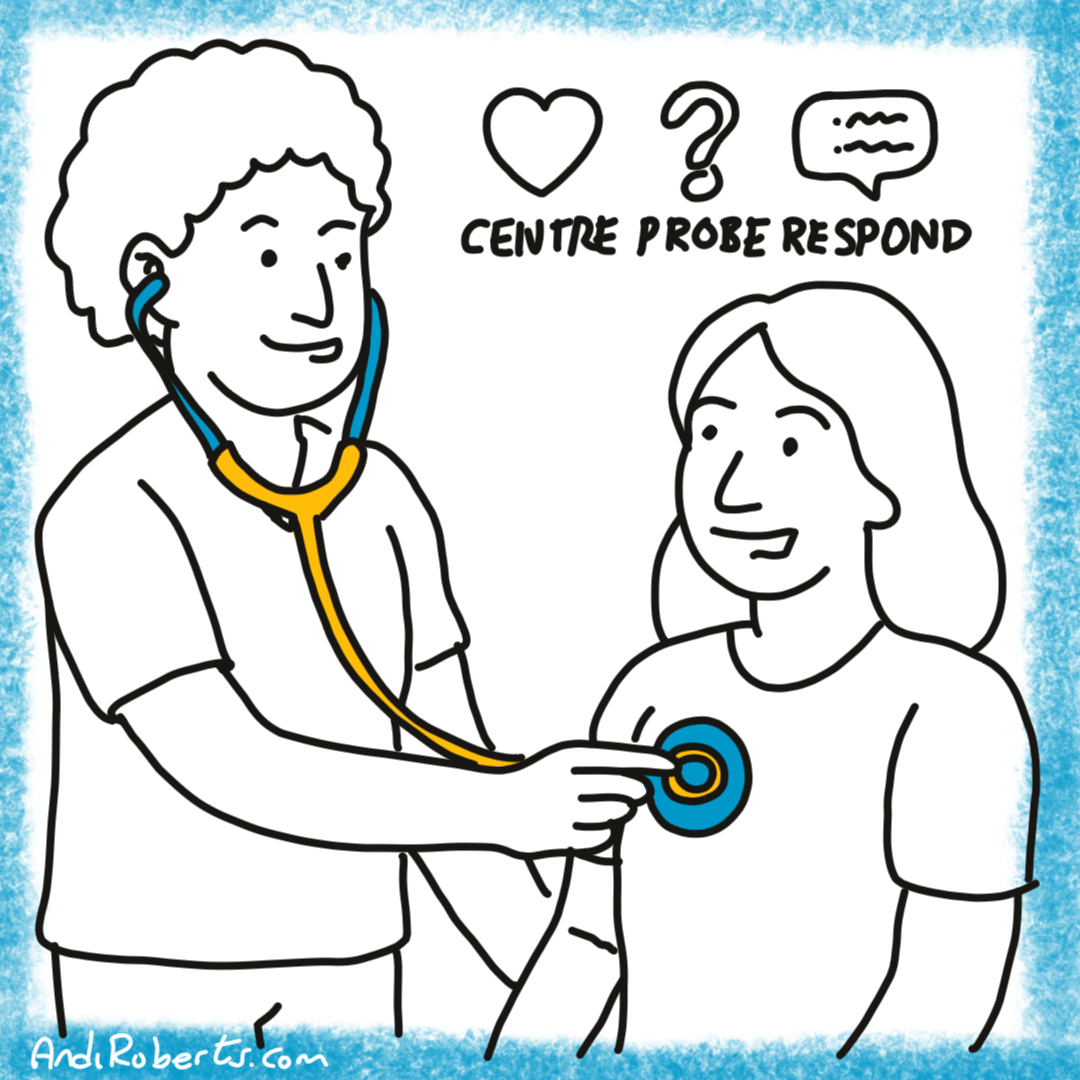As an executive coach, I have seen dozens of leaders struggle in moments when feedback lands, sometimes softly, sometimes like a stone dropped into still water. It’s rarely the content that unsettles them; it’s what it awakens. Even accomplished leaders, who make daily decisions affecting budgets, teams, and strategy, can find themselves thrown off balance when told something about their behaviour that doesn’t fit their own story.
What I have learned from these conversations is that feedback is not really about performance; it’s about relationship. It tests our ability to stay open under pressure, to hear what we might prefer not to, and to respond with curiosity instead of defence. The question isn’t simply “How do I take feedback well?” but “How do I remain connected, centred, and accountable when my identity feels at stake?”
One model that helps many of my clients find their footing is the RADAR process, developed by Anthony Ryland of Tap’d Solutions, a simple framework for receiving feedback: Repeat, Ask, Discuss, Align, Reflect. Think of it as a navigation system for staying oriented in moments that can easily spiral. But RADAR is more than a sequence of steps; it’s a discipline of presence. Each stage invites a shift in posture, from reactivity to reflection, from isolation to connection.
R — Repeat: The discipline of truly hearing
In every feedback conversation, the first few seconds are crucial. That’s when instinct kicks in, the silent “That’s not fair,” or “You don’t understand.” Those inner defences are normal; they’re simply the brain’s way of protecting identity. Yet what a leader does in that first moment determines whether the conversation opens up or shuts down.
Repeating what you have heard, calmly, without sarcasm or rush, is one of the simplest and most powerful ways to stay grounded. It slows the tempo and signals genuine attention. More importantly, it buys you time to breathe and recalibrate. Repetition isn’t about agreeing; it’s about acknowledging. It demonstrates to the other person that their message has landed, even if you’re not yet ready to respond to it.
When you mirror back words or meaning, you create a small island of safety in a turbulent exchange. You also help prevent misunderstanding, which is often what derails feedback most.
Example:
Manager: “In meetings, you tend to dominate the conversation.”
You: “So what I’m hearing is that I speak a lot, and that may leave less room for others, is that right?”
This kind of response seems simple, but it changes everything. It lowers tension and shows respect. It communicates, “I’m listening,” instead of “I’m preparing to defend.” And in that space, trust begins to rebuild.
Repeating well requires restraint, to hold back the impulse to explain or justify. As leaders, we often believe that understanding comes from our expertise; in feedback, understanding comes from our listening.
A — Ask: Curiosity before certainty
Once you’ve demonstrated that you’ve heard, the next move is to ask. This step is not about challenging or cross-examining; it’s about seeking clarity. Many leaders skip it because they assume they already know what the other person means. They don’t. And acting on half-understood feedback often leads to misdirected effort or deeper frustration.
Curiosity is the antidote to defensiveness. By asking questions, you transform feedback from a monologue into a dialogue. You move from feeling judged to becoming a learner. The key is to keep your tone light and open, your questions short and genuine.
In practice, this might sound like:
“When you say I could be more professional, could you share a specific example of when that didn’t come across as you hoped?”
Questions like this do three things: they clarify meaning, they slow the conversation to a human pace, and they show that you care enough to understand. They also help surface the other person’s expectations, which is where growth opportunities usually hide.
Sometimes the act of asking softens the giver’s stance. When someone feels you are truly curious, they often become more generous, they start explaining, empathising, even supporting your improvement.
Example:
You: “Could you tell me what behaviour made you feel I wasn’t approachable?”
Colleague: “I think it was when you cut the discussion short last week, it felt abrupt.”
You: “That’s helpful. I didn’t realise it came across that way.”
Questions turn judgment into data. They give you something to work with rather than something to defend against.
Curiosity doesn’t mean you accept everything you hear; it means you seek to understand before deciding what’s valid. In the rush of leadership, curiosity is often the first casualty, yet it’s the quality that most defines mature leaders.
D — Discuss: From reaction to relationship
Discussion is where most feedback conversations either blossom or break down. Having listened and clarified, this is your opportunity to engage, to share perspective, express appreciation, or explore alternatives. But the tone you set matters. Discussion isn’t debate. The goal isn’t to win but to connect.
When leaders jump too quickly to explanation, feedback feels transactional. When they approach it as dialogue, it becomes developmental. A good discussion acknowledges the other person’s view, offers your own, and searches for common ground.
The art lies in balance. Acknowledge what’s true without collapsing into apology. Offer your view without invalidating theirs. If you disagree, do so with respect, not resistance. The best discussions are collaborative, not corrective.
Example:
Feedback giver: “Your report was thorough, but it came in later than expected.”
You: “I understand. I prioritised detail and missed the timeline. I can see how that caused pressure. I’ll work on balancing accuracy and speed next time.”
What’s striking here is tone, calm, thoughtful, unhurried. The leader doesn’t rush to self-justify; they hold the conversation as an equal exchange.
You might sometimes choose to explain context:
“I made that call because I thought speed mattered more at the time, though I see now it created an issue.”
Explanation is fine when it’s offered as understanding, not defence.
Healthy discussion is the heartbeat of trust. It shows that feedback is not a performance review but a relationship in motion. When people feel that their perspective matters, they become more open to yours.
A — Align and Commit: Turning talk into change
Alignment and commitment are where feedback turns into progress. Leaders often listen well but fail to act. They leave the conversation with insight but no follow-through. Alignment bridges that gap. It’s about agreeing on what will change and how success will be noticed.
Feedback is valuable only if it leads to different behaviour. But alignment doesn’t mean compliance. It means creating shared clarity about expectations and actions.
Example:
Feedback giver: “I’d like you to involve me earlier in major decisions.”
You: “That makes sense. I’ll bring you in at the concept stage next time and we can review together before final sign-off. Let’s check in after the next project to see if that works better.”
This response translates a vague request into a concrete commitment. It moves the conversation from emotion to design, from feeling criticised to co-creating improvement.
When you align, you shift the dynamic from “you vs me” to “us vs the issue.” That shift builds momentum. It tells the other person, “Your perspective has changed my approach.”
Alignment also builds accountability. Following through on feedback, even small adjustments, signals integrity. People notice. Over time, consistency in keeping commitments creates a climate where feedback is not feared but valued.
The practical tip here is to make commitments visible. Summarise them at the end of the conversation, note them briefly in your planner, and revisit them later. When you demonstrate progress, you send a powerful message: feedback with me doesn’t disappear, it makes a difference.
R — Reflect: Learning that endures
The final step, Reflect, often determines whether feedback becomes temporary adjustment or lasting learning. Reflection is where the emotional residue settles and insight takes root.
After every significant feedback conversation, I encourage leaders I coach to pause, not to analyse, but to sit with what was said. What emotions surfaced? What part of you wanted to resist? What truth might have been hiding behind the tone or the delivery?
Without reflection, feedback can become performative: a box to tick, an act of compliance. With reflection, it becomes developmental: a mirror for self-awareness. Some leaders find that journaling helps. Others take a short walk, or talk it through with a trusted colleague. The method doesn’t matter; what matters is the pause. Reflection slows experience down long enough for meaning to form.
Example:
You might recall a conversation about interrupting colleagues and realise, in quiet reflection, that your interruptions stem not from dominance but enthusiasm. That insight reframes the issue: you don’t need to suppress your energy; you need to channel it differently.
Reflection also reveals patterns, the themes that recur across feedback from different people. Those patterns are rarely coincidences; they are usually the core learning edge of your leadership.
In leadership, reflection is not indulgence. It is maintenance, the emotional equivalent of sharpening your tools.
Putting it all together: Feedback as a leadership practice
When you combine these five steps, Repeat, Ask, Discuss, Align, Reflect, something subtle but profound happens. Feedback shifts from a threat to an act of collaboration.
Imagine a typical exchange. Your manager says:
“Your presentation had excellent data, but it was difficult to follow.”
You respond:
-
Repeat: “So the data was strong, but the flow made it harder to follow?”
-
Ask: “Which part felt least clear to you?”
-
Discuss: “That makes sense, I went straight into detail, and I can see how that lost people.”
-
Align: “Next time I’ll open with a summary and storyline. Can I run the outline by you beforehand?”
-
Reflect: Later, you note: “I tend to assume people want detail first. I’ll practise summarising before diving in.”
The content of the feedback hasn’t changed, but the experience has. Instead of feeling diminished, you’ve created a shared plan for improvement and strengthened trust in the process.
When leaders model RADAR, their teams notice. Over time, a culture forms where feedback becomes less about fault-finding and more about collective growth. It signals that honesty is safe, listening is expected, and change is normal.
In practical terms, this means fewer surprises in performance reviews, faster development, and a deeper sense of psychological safety across teams. But beyond metrics, the real gain is relational: people feel heard, seen, and valued.
Conclusion: Feedback as connection, not correction
I often remind the leaders I coach that feedback is not a verdict on who you are; it is a conversation about who you might become. The RADAR process is a structure for staying open to that possibility. It keeps you oriented when emotion threatens to take over.
Receiving feedback well is, in many ways, the ultimate leadership test. It reveals whether you can handle truth without losing composure, and whether you can stay in relationship while facing your own imperfections.
When a leader listens fully, asks with curiosity, and responds with grace, something shifts in the organisation. People begin to mirror that behaviour. Candour becomes easier. Meetings become safer. Energy that was once spent managing perception gets redirected into improving performance.
The most respected leaders I know are not the ones who are unshakeable, but those who are teachable. They have learned that every piece of feedback, even when clumsily delivered, carries a fragment of truth worth examining. They use RADAR not just to manage conversations, but to navigate growth.
So when the next piece of feedback comes your way, resist the instinct to defend. Pause. Listen. Let it land. Then take a moment for honest reflection:
-
How do I typically react when I receive feedback: do I open up, shut down, or explain it away?
-
When was the last time I actively asked for feedback rather than waited for it to find me?
-
Who do I trust to tell me what I most need to hear, and how often do I invite those voices in?
-
If I treated feedback as a skill to be practised, what small change would I make in my next conversation?
Leadership is not about always being right; it’s about always being ready to learn. The RADAR process helps us stay ready, alert, calm, and capable of turning even uncomfortable truth into growth.
In the end, that is what defines mature leadership: not perfection, but the courage to stay open, the humility to listen, and the discipline to act on what we hear.
Do you have any tips or advice for receiving feedback?
What has worked for you?
Do you have any recommended resources to explore?
Thanks for reading!





Leave A Comment